 |
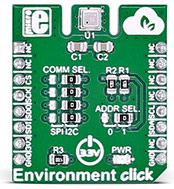
|
|
Environment click measures temperature, relative humidity, pressure and VOC (Volatile Organic compounds gases). The click carries the BME680 environmental sensor from Bosch. Environment click is designed to run on a 3.3V power supply. It communicates with the target microcontroller over SPI or I2C interface.
You can use it to test your indoor air quality, to control HVAC (heating, ventilation, and air conditioning) systems, in a weather station, sports applications and more. |
|
|
|
 |
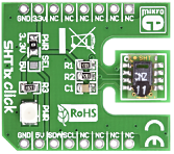
|
|
The SHT11 Click board is an accessory board in mikroBus form factor. It includes a SHT11 digital humidity and temperature sensor. A unique capacitive sensor element is used to measure relative humidity while the temperature is measured by a band-gap sensor. Serial I2C interface and factory calibration allow fast and easy system integration. The board is set to use the 3.3V mikroBus power supply by default, however soldering the PWR SEL SMD jumper to the 5V position will allow it to be used with 5V mikroBus systems. |
|
|
|
 |
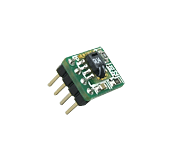
|
|
The SHT1X PROTO Board is used to connect your prototype device with a temperature/humidity sensor. It features the SHT11 sensor that uses a 2-wire serial interface, thus enabling you to measure temperature and humidity. |
|
|
|
 |
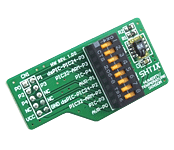
|
|
The SHT1X Board features the SHT11 sensor. It is connected to a development board through a 2-wire serial interface, thus enabling you to measure temperature and humidity. |
|
|
|
 |
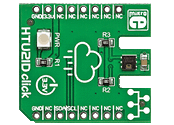
|
|
HTU21D click carries a high-precision, easy-to-use relative humidity sensor with temperature output. It's a great solution for quickly developing reliable environmental sensing nodes. The sensor is plug and play, requiring no calibration to use. The measurement range of HTU21D click is from 0 to 100 percents of relative humidity, and -40 to +125 degrees of Celsius. The board communicates with the target microcontroller through mikroBUS I2C lines: SCL (clock) and SDA (data). The default resolution of the signal is set to 12-bit for relative humidity and 14-bit for temperature readings. HTU21D click uses a 3.3V power supply. |
|
|
|
 |
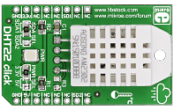
|
|
DHT22 click is a temperature and humidity measurement board carrying the sensor of the same name. It's a low cost reliable solution that communicates with the target board microcontroller through a single Serial Data Line. The sensor can detect temperatures between - 40 and 80 degrees centigrade with a half a degree precision. The relative humidity measurement from 0 - 100% is accurate within 2%. DHT22 has two jumpers. One for choosing between two mikroBUS pins (CS or INT) for communicating with the target board microcontroller. Another for setting up the power supply voltage either at 3.3V or 5V. |
|
|
|
 |
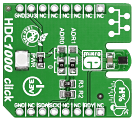
|
|
HDC1000 click is a humidity (and temperature) measurement click board carrying the HDC1000 sensor from TI. Its chief features are low power consumption, precision, and resistance to dust, dirt, and similar environmental contaminants. The relative humidity (0-100%RH) is measured with an accuracy of ±3%; the temperature is measured within a range from -20°C to 85°C with ±0.2°C accuracy. HDC1000 click communicates with the target board MCU through mikroBUS I2C and INT lines. It operates as a slave device on the I2C interface. A pair of onboard jumpers allow you to specify the slave byte address, with four to choose from. The board is designed to use a 3.3V power supply only. |
|
|
|
 |
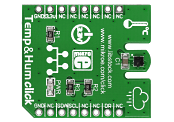
|
|
Temp&Hum click carries ST’s HTS221 temperature and relative humidity sensor. Its temperature measurement accuracy is ±1°C within a 0-60°C range. The precision is increased to ±0.5°C in a narrower range from 15 to 40°C. The highly sensitive relative humidity measurement range is from 0 to 100% with ±6% accuracy (or ±4.5% in the 20-80% range). The measurements are output in 16-bit resolution through the mikroBUS I2C interface. The board uses a 3.3V power supply. |
|
|
|
 |
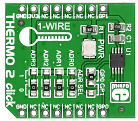
|
|
Thermo 2 click carries DS1825, a programmable resolution digital thermometer IC. It measures temperature within a range from - 10°C to 85°C with +/-0.5°C accuracy. You can specify the resolution of the measurements, from 9 to 12-bit, depending on the application. The board communicates with the target microcontroller through a 1-wire interface. Using the onboard jumper, you can choose between two mikroBUS pins for setting the output. Thermo 2 click also features four Address Select jumpers for setting a unique ID for the sensor (allowing for up to 16 sensors to operate on a single 1-Wire bus). |
|
|
|
 |
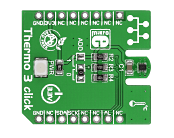
|
|
Thermo 3 click carries TMP102, a digital temperature sensor IC with a tiny footprint of only 1.6mm x 1.6mm.. Without requiring calibration, TMP102 is accurate within 0.5°C. Measurement range is between -25°C to 85°C. An integrated 12-bit ADC allows for measurement resolutions down to 0.0625°C. Thermo 3 click communicates with the target board MCU through mikroBUS I2C pins (SCL, SDA), and an additional Alert pint (INT on the default mikroBUS configuration). The board is designed to use a 3.3V power supply only. |
|
|
|
 |
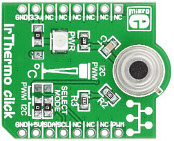
|
|
IrThermo Click features either the MLX90614ESF-BAA (3.3V) or MLX90614ESF-AAA (5V) single zone infrared thermometer module capable of non-contact temperature measurements. It is calibrated in wide temperature ranges: -40 to 85°C for the ambient temperature and -70 to +380°C for the object temperature (-20 to 120°C in PWM mode). IrThermo Click communicates with the microcontroller via mikroBUS I2C lines (SCL, SDA) or PWM line. The sensor is ideal for automotive use, industrial temperature control, body temperature measurement, movement detection, air conditioning control and more. |
|
|
|
 |
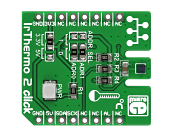
|
|
IrThermo 2 click is a non-contact temperature measurement solution. The click board carries the TMP007 infrared thermopile sensor with an integrated math engine. The sensor absorbs the infrared radiation emitted by the target object (within the sensor's field of view) and the integrated math engine calculates its temperature by comparing it with the temperature of the silicon die. The measurement range of the sensor is between -40°C to 125°C (with a 14-bit resolution). The board is designed to use either a 3.3V or a 5V power supply. |
|
|
|
 |
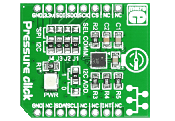
|
|
Pressure Click is a compact and easy solution for adding pressure measurement to your design. It features the LPS331AP digital output pressure sensor. The LPS331AP IC is an ultra compact absolute piezoresistive pressure sensor capable of measuring pressure (260-1260 mbar) or temperature (-40°C to 80°C) and provides a digital signal output to your microcontroller. Pressure Click communicates with the target board microcontroller via mikroBUS SPI (MOSI, MISO, SCK, CS), I2C (SDA, SCL) and INT lines. The board is designed to use a 3.3V power supply only. |
|
|
|
 |
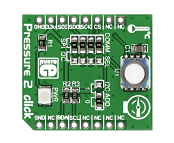
|
|
Pressure 2 click carries an MS5803, a high resolution MEMS pressure sensor that is both precise and robust. Its measurement range is from 0 to 14 bars (with a resolution of up to 0.2 mbars), but because of the stainless steel cap enclosure, the sensor can withstand up to 30 bars of pressure. Pressure 2 click communicates with the target board MCU either through mikroBUS SPI or I2C lines, depending on the position in which the onboard jumpers are soldered. |
|
|
|
 |
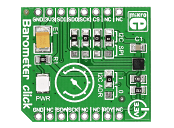
|
|
Barometer click carries the LPS25HB IC, which is a piezoresistive absolute pressure sensor with a measurement range from 260 to 1260 hPa (with a 24-bit resolution output). It's a high precision sensor and high resolution mode it can measure pressure within 0.01 hPa RMS. A low resolution mode can be implemented to reduce power consumption. Barometer click can communicate with the target board MCU either through I2C or SPI pins (which is specified by soldering onboard jumpers in appropriate position). An interrupt pin is also available, which can be configured either as Data Ready (sends signal when pressure value changes) or as a threshold trigger (sends signal when specified high or low pressure value is reached). The board uses a 3.3V power supply only. |
|
|
|
 |
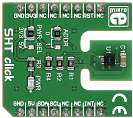
|
|
SHT click is a temperature and humidity sensing click board that carries Sensiron's SHT3x-DIS IC. Compared to its predecessor (SHT11), SHT3x click has increased reliability and enhanced signal processing features with a high signal-to-noise ratio. Best measurement results are achieved within a 5-60° temperature range (0.015 resolution) and a 20%–80% RH humidity range (0.01 resolution). SHT click outputs a fully calibrated, linearized, and temperature compensated digital output through the mikroBUS I2C interface (SCL, SDA). An additional INT pin is for setting up alerts for certain temperature or humidity values. Finally, a RST pin allows you to reset the sensor. Designed to use either 3.3V or 5V power supply. |
|
|
|
 |

